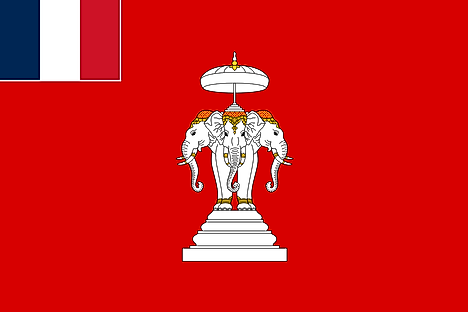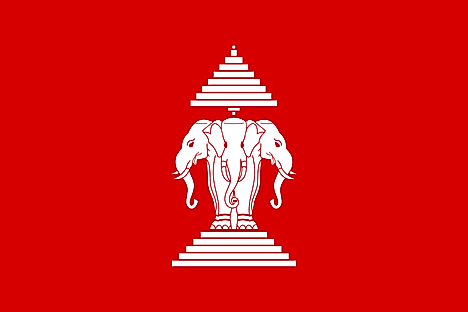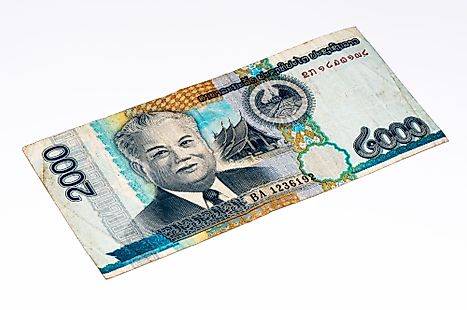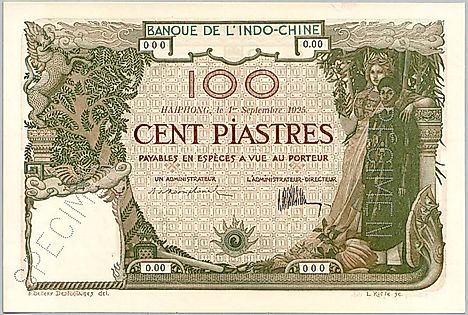Flags, Symbols, & Currencies of Lao
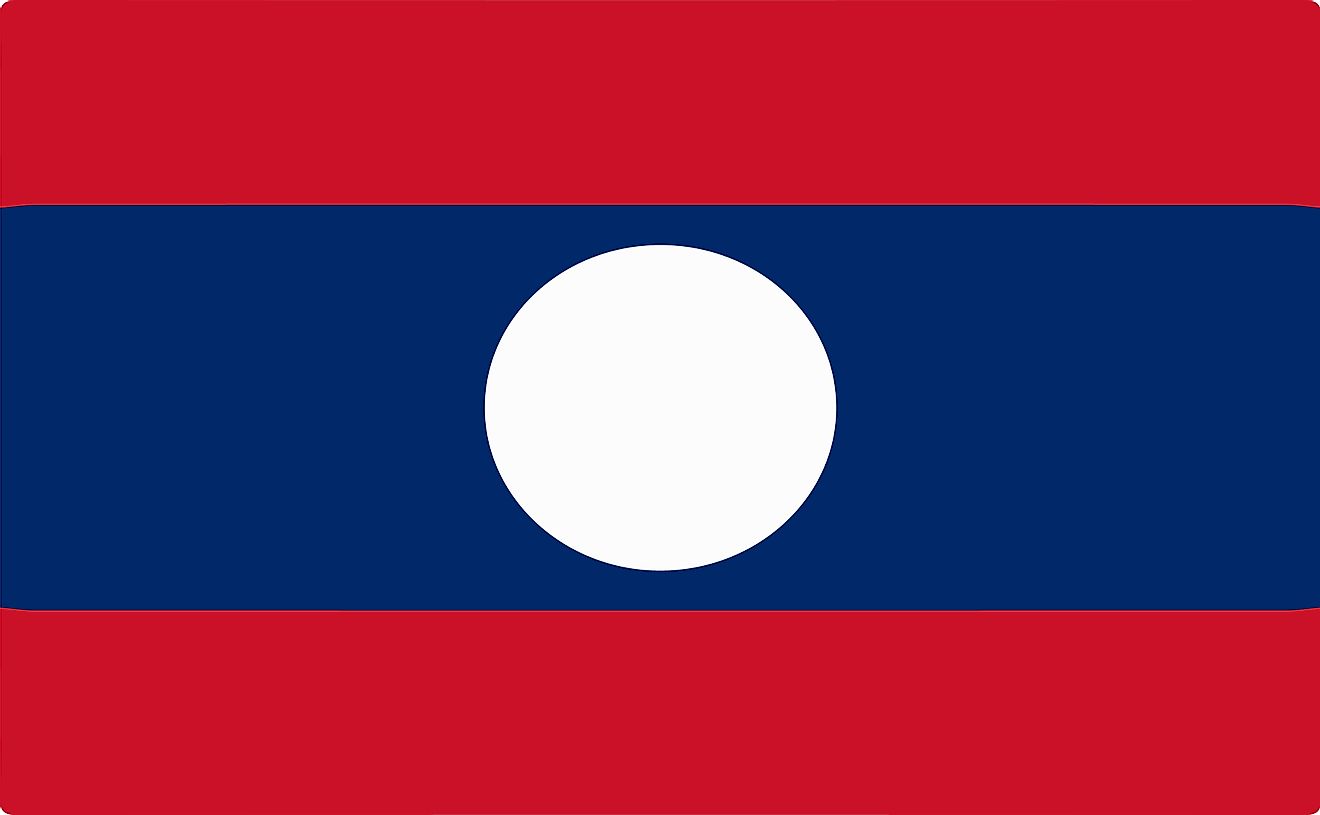
The Laos flag was officially adopted on October 12, 1945,and readopted on December 2, 1975. It replaced the red flag with tripple-headed elephant used by the Kingdom of Luang Phrabang. The flag of Laos consists of three horizontal bands of red (top), blue (double width), and red with a large white disk centered in the blue band. The disc's diameter is four-fifth the height of the blue band. The flag's height to width ratio is 2:3. The flag of Laos is one of the only two communist countries that does not use any of the communist symbols (the other is the Cuban flag).
The red bands is symbolic of the the blood shed for liberation on both banks of the Mekong River. The blue color represents the Mekong River and prosperity. The white disk symbolizes the full moon against the Mekong River and also signifies the unity of the people under the Lao People's Revolutionary Party, as well as the country's bright futureLaos
History of the Flag
The blue and red flag was designed by Maha Sila Viravong in 1945. He was the member of the Lao Issara government tasked with designing a new national flag distinct from the Royal flag. He ws inspired by Thailand's adoption of the tricolor red-white-blue flag as a replacement of the traditional royalist flag. Maha's flag was adopted on October 12, 1945. However, it was only used until 1946 when the French took over Laos in 1946. From 1952 to 1975, the country used a red flag with with three-headed elephant standing on a pedestal and covered by nine-folded umbrella. Following the fall of the royal government in 1975, the country readopted the red and blue flag as the national flag.
Symbols of Lao People's Democratic Republic
National Coat of Arms of Laos
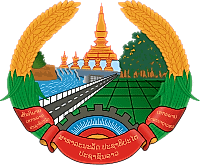
Adopted in 1991, the emblem of Laos depicts several features that represents the economic and religious aspects. It circular emblem depicting the national shrine Pha That Luang flanked by tips of stalks of rice. In the middle of the circle are a forest, paddy field, and hydropower dam. A road separates the paddy field from the dam. At the bottom of the circle are a red cog wheel and a red ribbon with the inscriptions in Lao script: "Lao People's Democratic Republic." On each sides of the ribbon are stalks of rippen rice with red ribbons bearing the inscription: "Peace, independence, democracy, unity and prosperity" and
National Anthem
- Anthem Title: Pheng Xat Lao (Hymn of the Lao People)
- Music composer and Lyricist: Dr. Thongdy Sounthonevichit
- Date of Adoption: 1945 (readopted in 1975)
Pheng Xat Lao or Hymn of the Lao People is the national anthem of Lao. The anthem was adopted froma song written an composed by Dr. Thongdy Sounthonevichit in 1941. Phang Sat Lao was first adopted as the national anthem of the Kingdom of Lao in 1945. However, the lyrics were revised following the victory in the Laotian Civil War and establishment of Lao as a republic in 1975. The new lyrics were written by Sisana Sisane.
Pheng Xat Lao (Lao)
ຊາດລາວຕັ້ງແຕ່ໃດມາ
ລາວທຸກທົ່ວຫນ້າເຊີດ
ຊູສຸດໃຈ
ຮ່ວມແຮງຮ່ວມຈິດ
ຮ່ວມໃຈ
ສາມັກຄີກັນເປັນ
ກຳລັງດຽວ
ເດັດດ່ຽວພ້ອມກັນ
ກ້າວຫນ້າ
ບູຊາຊູກຽດຂອງລາວ
ສົ່ງເສີມໃຊ້ສິດເປັນເຈົ້າ
ລາວທຸກຊົນເຜົ່າ
ສະເໝີພາບກັນ
ບໍ່ໃຫ້ພວກຈັກກະພັດ
ແລະພວກຂາຍຊາດ
ເຂົ້າມາລົບກວນ
ລາວທັງມວນຊູ
ເອກະລາດ
ອິດສະຫລະພາບຂອງ
ຊາດລາວໄວ້
ຕັດສິນໃຈສູ້ຊີງເອົາໄຊ
ພາຊາດກ້າວໄປສູ່
ຄວາມວັດທະນາ
Hymn of the Lao People
For all time, the Lao people
Have glorified their
Fatherland,
United in heart,
Spirit and vigor as one.
Resolutely moving forwards,
Respecting and increasing the dignity of
the Lao people
And proclaiming the right to be their own
masters.
The Lao people of all origins are equal
And will no longer allow imperialists
And traitors to harm them.
The entire people will safeguard the
independence
And the freedom of the Lao nation.
They are resolved to struggle for victory
In order to lead the nation to prosperity
The Currency of Lao People's Democratic Republic is the Lao kip
The official currency of Laos is the Lao kip, introduced in 1955. The currency's name is derived from Lao's word meaning"ingot." A kip is subdivided into 100 att and the currency represented by the sign ₭. The free Lao kip was introduced in 1946 but was replaced almost immediately by the French Indochinese piastre until 1955. Kip was reintroduced in 1955.
Coins and Banknotes
When Royal kip was reintroduced, coins were minted in the denominations of 10, 20, and 50 att and banknotes came in the denominations of 1, 5, and 100 kip. In 1957, the notes were printed in the denominations of 1, 5, 10, 20, and 50-kip notes. In the following years, several other denominations were introduced, including 100, 200, 500, 1000, and 5000 kips. The Pathet Lao kip introduced in 1976 did not have 1000 and 5000 denominations. Today, the frequently used banknotes are in the denominations of 500, 1000, 2000, 5000, 10,000, 20,000, 50,000, and 100,000 kip. The coins are rarely used.
Historical Currencies of Laos
In the late 19th century, Fance added Laos to the French Indochina, effectively bringing it under the colonial control. Laos adopted the French Indochinese piastre and used it as the official currency until 1952. Piastre coins were introduced in 1883 and were mainly made of silver and bronze. During the World War II, nickel and zinc coins were introduced. Piastre notes were introduced in 1892 and by 1920 the notes were in several denominatios, including 1, 5, 10, 20, and 50 cent notes. The use of Piastre was temporarily stopped in Laos between 1945 and 1946, with the introduction of Free Lao kip. However, the French took control of the region and reintroduced the piastre. In 1955, Lao kip was again reintroduced as the official currency and has remained in circulation to date.
